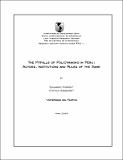|
Reseña:
|
Policymaking in Peru over the last 25 years has been largely dominated by the Executive, and has been influenced by a variety of structural and political factors as well as by the personal ambitions of presidents and the public perception of crisis. With few exceptions, neither the Congress nor the other branches and levels of government have played effective roles in defining the national policy agenda, promoting inter-temporal cooperation and providing checks and balances on executive power. This is due in part to constitutional arrangements, in part to electoral outcomes, and in part to the historical weaknesses of political parties and other actors. Although this situation has been partially modified since 2001, it is not clear that the general pattern has changed.While certain arenas of decision-making have been reformed in recent years, in many spheres policymaking remains an arbitrary and unpredictable process, resulting in policies that are of low quality, poorly enforced and easily reversed. Although reforming aspects of the political and electoral systems could contribute to improving this outcome, the instability of the political regime per se has been a deterrent to longer-term institutional development. |

